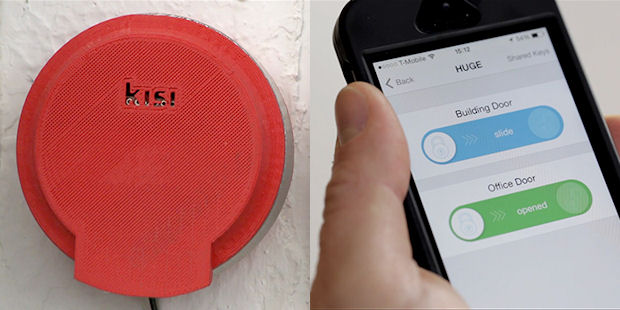Rapid Prototyping Opens Doors for Kisi
Latest News
June 27, 2014
 Dear Desktop Engineering Reader:
Dear Desktop Engineering Reader:
How many of you remember the 90’s ultra-connected hipster doofus getting on the plane in front of you? I was one. I had a knapsack, a brick-sized radiophone with a collapsible antenna, a pager, an 18-pound laptop, a CD player, a game player, a PDA, a copy of USA Today and a gaggle of jingling keys hung on my belt loop. All I needed was a folded yurt, a kettle and a goat to roast to finish the tableau. Today, we’ve packed most of that stuff onto a smartphone, but lots of us still have that bunch of keys in our handbag or man-purse.
At the far end of today’s Check it Out link is a quick case study combining a three-minute video and a short read that demonstrates how far we’ve come from our recent “lugging-stuff with us” past. The best part of it is that this presentation combines a smartphone application with 3D rapid manufacturing to get rid of one more anachronism you tote around with you. You’ll wonder why you didn’t think of it.
OK, so, these German guys win a new ideas contest and then setup a shop in Brooklyn, NY, to build Kisi – pronounced Key-zee. That’s the same name as the company, BTW.
Kisi is this nifty device that looks like it’s the size of a hockey puck. What Kisi does is that it lets you use your smartphone as a keycard. No more swiping a card to get into your office, and you can retire your Monday ritual of walking back to your car to retrieve the cardkey you tossed in the glove box on Friday. You pull out your smartphone and tell Kisi to unlock the door. Bonus: You can send access keys to people via secure e-mail when they need to get in.
Setting Kisi up seems a breeze. What you do is mount the Kisi unit inside – yes, inside – your office, home or wherever and connect it to the keypad. You then establish wireless communications between the Kisi hardware and its complimentary app. You’re done. You may now forget your cardkey.
The Kisi hardware is interesting stuff, and it’s where rapid manufacturing comes into the story. The guys at Kisi once used an off-the-shelf box to house the electronics, but switched to cases they made themselves with a MakerBot Replicator 2 Desktop 3D Printer. One of the co-founders explains that he had experience with expensive high-end 3D additive manufacturing systems while in college, so he knew what the technology could do for Kisi. A MakerBot, however, is a 3D manufacturing system he could afford in his startup business.
Today, Kisi also uses the MakerBot Replicator 2 to make parts for the Kisi device housing. The housing itself is made up of PLA (polylactic acid) thermoplastic filament with aluminum and laser-cut wood.
Kisi credits the MakerBot Replicator 2 for giving them a number of benefits. For one, Kisi can keep its manufacturing local, which has nothing to do with the fact that the MakerBot factory is also in Brooklyn. Rather, it keeps them in control of their manufacturing and enables them to respond quickly to customer feedback and special requests. Having the MakerBot Replicator 2 in house also lets them build freeform shapes and prototype new designs constantly.
On one level, “Rapid Prototyping Opens Doors for Kisi” is simply good, quick fun to read and watch. But on another level, it’s a head-slapper. It’s one of those stories that makes you say “I can do something like that.” Low-cost, high-function 3D printing with the MakerBot Replicator empowered Kisi to realize their vision and make an eminently practical and handy device that simplifies our lives. Hit the Check it Out link and see for yourself. Good stuff.
Thanks, Pal. – Lockwood
Anthony J. Lockwood
Editor at Large, Desktop Engineering
Read and watch “Rapid Prototyping Opens Doors for Kisi” here.
Subscribe to our FREE magazine, FREE email newsletters or both!
Latest News
About the Author
Anthony J. Lockwood is Digital Engineering’s founding editor. He is now retired. Contact him via [email protected].
Follow DE






